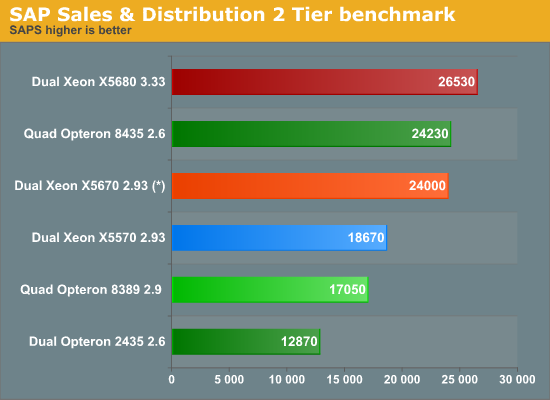The Intel Xeon 5670: Six Improved Cores
by Johan De Gelas on March 16, 2010 3:39 PM EST- Posted in
- IT Computing
SAP Sales and Distribution 2-tier
The SAP SD (sales and distribution, 2-tier internet configuration) benchmark is an interesting benchmark as it is a real world client-server application. We decided to take a look at SAP's benchmark database. The results below all run on Windows 2003 Enterprise Edition and MS SQL Server 2005 database (both 64-bit). Every 2-tier Sales & Distribution benchmark was performed with SAP's latest ERP 6 enhancement package 4. These results are NOT comparable with any benchmark performed before 2009. The new 2009 version of the benchmark produces scores that are 25% lower. We analyzed the SAP Benchmark in-depth in one of our earlier articles. The profile of the benchmark has remained the same:
| SAP S&D 2-Tier | |
| Operating System | Windows 2008 Enterprise Edition |
| Software | SAP ERP 6.0 Enhancement package 4 |
| Benchmark software | Industry Standard benchmark version 2009 |
| Typical error margin | Very low |
No results were available for the Xeon X5670, so we estimated the expected performance of the Xeon X5670 based on the X5680 result that Fujitsu published and on some preliminary industry reports.

(*) Estimated result
The six-core Xeon is no less than twice (!) as fast as the six-core Opteron in a similar configuration. Pretty dramatic results, but not unexpected of course as the six-core Opteron could never come close to the quadcore Xeons in the first place, let alone an improved six-core version of the latter. The reasons are many-fold, but one of the important ones is the fact that Hyperthreading boosts performance by at least 30%.
Even worse, 12 Westmere cores are enough to come very close to the performance of a 24-core Opteron machine. This is does not bode well for the newest octal and twelve-core Opterons (Magny-cours). To be really frank, we think the SAP market is Intel owned until AMD launches the multi-threaded Bulldozer CPU. Most of the SAP server market is not very sensitive to pricing, let alone CPU pricing. SAP projects, which need expensive licenses and many consulting hours are typically in the $100K to $100M range and x86 hardware costs are most of the time only a small percentage of the total project costs. The final blow is the appearance of the Nehalem EX at the end of this month.










40 Comments
View All Comments
behrouz - Wednesday, March 17, 2010 - link
why did you not test magny core ?JohanAnandtech - Wednesday, March 17, 2010 - link
For the same reason that there are no Magny-Cours benchmarks on AMD's site yet :-).drewintheav - Tuesday, March 16, 2010 - link
The INTEL i7 980X has dual QPI's and will run in a dual socket mainboard!!! Such as the EVGA W555 /Classified SR-2Lukas - Thursday, March 18, 2010 - link
No, i7 980X has only a single QPI link. But i'm pretty sure there's a corresponding W56xx CPU, with two QPI links and twice the price tag.thunng8 - Tuesday, March 16, 2010 - link
"server CPU architecture which already has the fastest cores on the market and you’ll get very impressive results"This is not entirely correct. If you limit your self to x64 architecture, it is correct, but the recently released IBM POWER7 8 core chip blows away the Nehalem architecture in the benchmarks released so far.
For example, a 4 chip, 32 core 3.55Ghz POWER7 server does 85,220 SAPS in the SAP SD 2 tier benchmark and that isn't even the top bin POWER7. (top bin is 3.86Ghz with double the memory bandwidth / core) There are even larger margins in other benchmarks like specIntRate etc.
Photubias - Thursday, March 18, 2010 - link
Just curious: what software (OS/applications) run on that 8Core POWER7 chip?Lukas - Thursday, March 18, 2010 - link
Linux, AIX, IBM i, z/OSThat's pretty much it. Lot's of traditional OLTP workloads run on those platforms. Several flight booking systems run on z/OS.
Penti - Thursday, March 18, 2010 - link
z/OS runs on System Z systems with z10 CICS processors. Eg Mainframes.IBM System i servers are just high-end POWER servers. Running mainly Java and database loads, directly on IBM i/OS (previously i5/OS and before that AS/400) or AIX, or Linux. IBM DB2 is integrated directly into IBM i/OS.
Torment - Thursday, March 18, 2010 - link
And what does that setup cost?vitchilo - Tuesday, March 16, 2010 - link
What would be great is ONE game test... like Crysis or something...And ONE X264 encode test...
Thanks a lot.